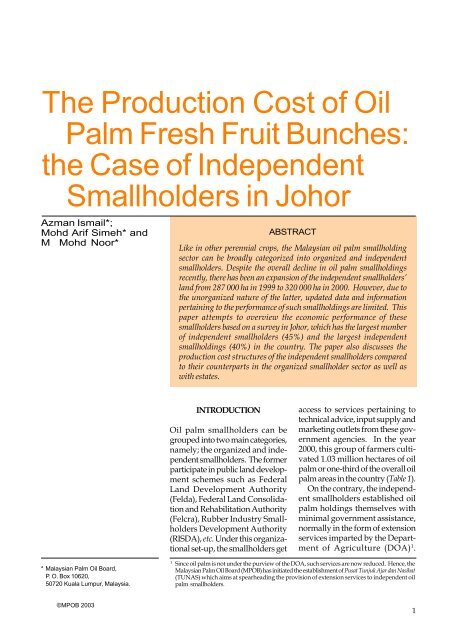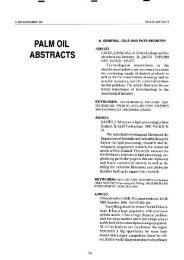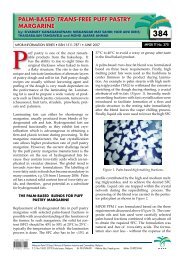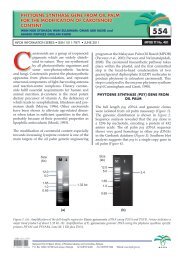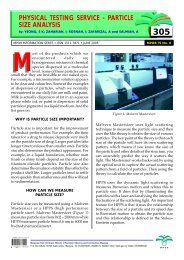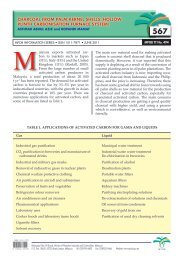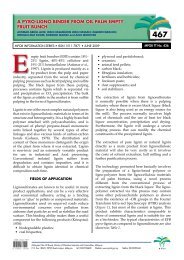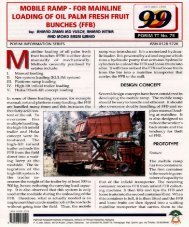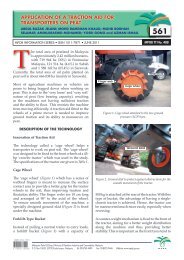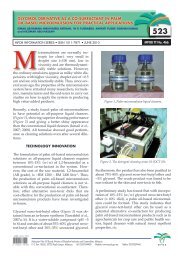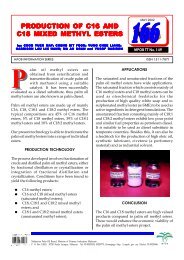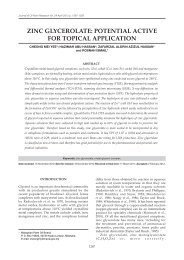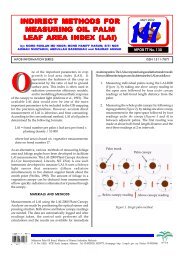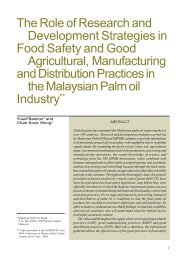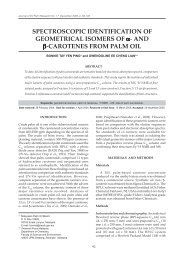The Production Cost of Oil Palm Fresh Fruit Bunches: the Case of ...
The Production Cost of Oil Palm Fresh Fruit Bunches: the Case of ...
The Production Cost of Oil Palm Fresh Fruit Bunches: the Case of ...
You also want an ePaper? Increase the reach of your titles
YUMPU automatically turns print PDFs into web optimized ePapers that Google loves.
THE PRODUCTION COST OF OIL PALM FRESH FRUIT BUNCHES: THE CASE OF INDEPENDENT SMALLHOLDERS IN JOHOR<br />
<strong>The</strong> <strong>Production</strong> <strong>Cost</strong> <strong>of</strong> <strong>Oil</strong><br />
<strong>Palm</strong> <strong>Fresh</strong> <strong>Fruit</strong> <strong>Bunches</strong>:<br />
<strong>the</strong> <strong>Case</strong> <strong>of</strong> Independent<br />
Smallholders in Johor<br />
Azman Ismail*;<br />
Mohd Arif Simeh* and<br />
M Mohd Noor*<br />
* Malaysian <strong>Palm</strong> <strong>Oil</strong> Board,<br />
P. O. Box 10620,<br />
50720 Kuala Lumpur, Malaysia.<br />
ABSTRACT<br />
Like in o<strong>the</strong>r perennial crops, <strong>the</strong> Malaysian oil palm smallholding<br />
sector can be broadly categorized into organized and independent<br />
smallholders. Despite <strong>the</strong> overall decline in oil palm smallholdings<br />
recently, <strong>the</strong>re has been an expansion <strong>of</strong> <strong>the</strong> independent smallholders’<br />
land from 287 000 ha in 1999 to 320 000 ha in 2000. However, due to<br />
<strong>the</strong> unorganized nature <strong>of</strong> <strong>the</strong> latter, updated data and information<br />
pertaining to <strong>the</strong> performance <strong>of</strong> such smallholdings are limited. This<br />
paper attempts to overview <strong>the</strong> economic performance <strong>of</strong> <strong>the</strong>se<br />
smallholders based on a survey in Johor, which has <strong>the</strong> largest number<br />
<strong>of</strong> independent smallholders (45%) and <strong>the</strong> largest independent<br />
smallholdings (40%) in <strong>the</strong> country. <strong>The</strong> paper also discusses <strong>the</strong><br />
production cost structures <strong>of</strong> <strong>the</strong> independent smallholders compared<br />
to <strong>the</strong>ir counterparts in <strong>the</strong> organized smallholder sector as well as<br />
with estates.<br />
INTRODUCTION<br />
<strong>Oil</strong> palm smallholders can be<br />
grouped into two main categories,<br />
namely; <strong>the</strong> organized and independent<br />
smallholders. <strong>The</strong> former<br />
participate in public land development<br />
schemes such as Federal<br />
Land Development Authority<br />
(Felda), Federal Land Consolidation<br />
and Rehabilitation Authority<br />
(Felcra), Rubber Industry Smallholders<br />
Development Authority<br />
(RISDA), etc. Under this organizational<br />
set-up, <strong>the</strong> smallholders get<br />
access to services pertaining to<br />
technical advice, input supply and<br />
marketing outlets from <strong>the</strong>se government<br />
agencies. In <strong>the</strong> year<br />
2000, this group <strong>of</strong> farmers cultivated<br />
1.03 million hectares <strong>of</strong> oil<br />
palm or one-third <strong>of</strong> <strong>the</strong> overall oil<br />
palm areas in <strong>the</strong> country (Table 1).<br />
On <strong>the</strong> contrary, <strong>the</strong> independent<br />
smallholders established oil<br />
palm holdings <strong>the</strong>mselves with<br />
minimal government assistance,<br />
normally in <strong>the</strong> form <strong>of</strong> extension<br />
services imparted by <strong>the</strong> Department<br />
<strong>of</strong> Agriculture (DOA) 1 .<br />
1 Since oil palm is not under <strong>the</strong> purview <strong>of</strong> <strong>the</strong> DOA, such services are now reduced. Hence, <strong>the</strong><br />
Malaysian <strong>Palm</strong> <strong>Oil</strong> Board (MPOB) has initiated <strong>the</strong> establishment <strong>of</strong> Pusat Tunjuk Ajar dan Nasihat<br />
(TUNAS) which aims at spearheading <strong>the</strong> provision <strong>of</strong> extension services to independent oil<br />
palm smallholders.<br />
1
OIL PALM INDUSTRY ECONOMIC JOURNAL (VOL. 3(1)/2003)<br />
<strong>The</strong>se holdings are small and scattered.<br />
From Table 2, it is shown that<br />
<strong>the</strong>re were 87 717 independent<br />
smallholders in <strong>the</strong> year 2000.<br />
<strong>The</strong>y cultivated 320 835 ha <strong>of</strong> oil<br />
palm or 9.5% <strong>of</strong> <strong>the</strong> total oil palm<br />
areas in <strong>the</strong> country.<br />
Table 1 also shows that despite<br />
<strong>the</strong> overall decline in oil palm<br />
smallholdings from 1.37 million<br />
hectares in 1999 to 1.35 million<br />
hectares in 2000, <strong>the</strong>re has been<br />
an expansion <strong>of</strong> independent<br />
smallholdings 2 from 286 513 ha to<br />
320 818 ha. Consequently, <strong>the</strong> in-<br />
2<br />
Note: *Inclusive <strong>of</strong> Felda Plantations Sdn. Bhd.<br />
Source: MPOB (2001a).<br />
Source: MPOB (2001b).<br />
dependent smallholders’ land share<br />
has increased from 8.65% in 1999<br />
to 9.5% in 2000. Such a positive<br />
response was mainly attributed to<br />
favourable crude palm oil (CPO)<br />
prices vis-à-vis <strong>the</strong> prices <strong>of</strong> o<strong>the</strong>r<br />
commodities. Due to <strong>the</strong> unorganized<br />
nature <strong>of</strong> <strong>the</strong> independent<br />
smallholders, however, data and<br />
information pertaining to current<br />
performance and production cost<br />
<strong>of</strong> <strong>the</strong> independent smallholders<br />
are limited. Such evidence is<br />
crucial in view <strong>of</strong> <strong>the</strong> need to fur<strong>the</strong>r<br />
streamline <strong>the</strong> development <strong>of</strong><br />
<strong>the</strong> smallholders in <strong>the</strong> country.<br />
This paper attempts to discuss <strong>the</strong><br />
economic performance <strong>of</strong> <strong>the</strong>se<br />
independent smallholders in particular<br />
<strong>the</strong>ir production cost, based<br />
on a survey in Johor 3 .<br />
METHODOLOGY<br />
<strong>The</strong> study was conducted through<br />
a stratified random sampling<br />
survey. <strong>The</strong> independent smallholders<br />
from Johor were first listed<br />
from MPOB’s smallholders database.<br />
<strong>The</strong>y were later divided into<br />
TABLE 1. DISTRIBUTION OF OIL PALM PLANTED AREA BY CATEGORY: 1999-2000<br />
Category 1999 2000<br />
ha (%) ha (%)<br />
Federal government/<br />
Felda* 674 948 20.37 598 190 17.72<br />
Felcra 132 354 4.00 154 357 4.00<br />
Risda 41 561 1.25 37 011 1.10<br />
State schemes 235 565 7.11 242 002 7.17<br />
Total organized smallholders 1 084 428 41.38 1 031 560 29.99<br />
Independent smallholders 286 513 8.65 320 818 9.50<br />
Total smallholders 1 370 941 50.03 1 352 378 39.94<br />
Total 3 313 393 100.00 3 376 664 100.00<br />
TABLE 2. INDEPENDENT OIL PALM SMALLHOLDINGS IN MALAYSIA: 2000<br />
State No. (%) ha (%)<br />
Johor 39 711 45.26 125 459.83 39.10<br />
Perak 15 921 18.15 53 089.78 16.55<br />
Selangor 15 324 17.47 33 407.47 10.41<br />
Pahang 3 277 3.74 16 683.21 5.20<br />
N. Sembilan 2 015 2.30 11 057.93 3.45<br />
Kedah 1 485 1.69 10 045.77 3.13<br />
P. Pinang 1 119 1.28 6 869.02 2.14<br />
Melaka 626 0.71 4 212.29 1.31<br />
Terengganu 582 0.66 4 042.34 1.26<br />
Kelantan 103 0.12 1 128.96 0.35<br />
P. Malaysia 80 163 91.39 265 996.60 82.91<br />
Sabah 5 994 6.83 48 031.85 14.97<br />
Sarawak 1 560 1.78 6 807.21 2.12<br />
Malaysia 87 717 100.00 320 835.66 100.00<br />
2 <strong>The</strong> land areas under organized smallholdings have declined from 1 084 428 ha in 1999 to 1 031 560 ha in 2000.<br />
3 <strong>The</strong> survey was confined to Johor since it has <strong>the</strong> largest number <strong>of</strong> independent smallholders (45%) (Table 2) with a total area <strong>of</strong> 125 459.83 ha.
THE PRODUCTION COST OF OIL PALM FRESH FRUIT BUNCHES: THE CASE OF INDEPENDENT SMALLHOLDERS IN JOHOR<br />
four strata, which referred to <strong>the</strong><br />
selected districts namely: Batu<br />
Pahat, Muar, Kluang and Pontian.<br />
<strong>The</strong>se districts were selected<br />
because 89.6% <strong>of</strong> <strong>the</strong> total independent<br />
smallholders in Johor are<br />
from those areas (Table 3). In<br />
order to select <strong>the</strong> respondents<br />
from each stratum, <strong>the</strong> random<br />
number table was used. A total <strong>of</strong><br />
300 independent smallholders was<br />
interviewed and <strong>the</strong>ir distribution<br />
is as shown in Table 4.<br />
Source: MPOB (2001c).<br />
<strong>The</strong> survey was conducted in<br />
2001 with <strong>the</strong> cooperation <strong>of</strong> Johor<br />
DOA. <strong>The</strong> agriculture assistants <strong>of</strong><br />
DOA undertook a one month-long<br />
interpersonal interview with <strong>the</strong><br />
independent smallholders. Such<br />
efforts facilitated <strong>the</strong> search for<br />
information since <strong>the</strong> interviewers<br />
had readily established rapport<br />
with <strong>the</strong> smallholders.<br />
RESULTS AND DISCUSSION<br />
Background on <strong>Oil</strong> <strong>Palm</strong> Independent<br />
Smallholders<br />
Slightly more than threequarters<br />
(77%) <strong>of</strong> <strong>the</strong> independent<br />
smallholders were Malays. Chinese<br />
farmers comprised 22% and <strong>the</strong><br />
Indians made up only 1%. This is<br />
shown in Figure 1. <strong>The</strong> independent<br />
smallholders were<br />
relatively old. <strong>The</strong>ir average age<br />
TABLE 3. INDEPENDENT OIL PALM SMALLHOLDINGS IN<br />
JOHOR BY DISTRICT AND HECTARAGE, 2000<br />
District No. (%) ha (%)<br />
Batu Pahat 12 669 31.90 32 563.99 25.96<br />
Muar 8 420 21.20 23 727.63 18.91<br />
Kluang 8 304 20.91 30 764.67 24.52<br />
Pontian 6 186 15.58 18 844.94 15.02<br />
Johor Bahru 1 766 4.45 8 099.52 6.46<br />
Segamat 1 115 2.81 4 906.31 3.91<br />
Kota Tinggi 704 1.77 4 413.29 3.52<br />
Mersing 547 1.38 2 139.48 1.71<br />
Total 39 711 100.00 125 459.83 100.00<br />
TABLE 4. SIZE OF SAMPLES<br />
OF INDEPENDENT<br />
SMALLHOLDERS, BY<br />
DISTRICT IN JOHOR<br />
District Size <strong>of</strong> samples<br />
Batu Pahat 107<br />
Muar 71<br />
Kluang 70<br />
Pontian 52<br />
22%<br />
1%<br />
77%<br />
was 58.6 years with a range <strong>of</strong><br />
between 45 to 76 years (Table 5).<br />
Being relatively old, <strong>the</strong>y had little<br />
opportunity for <strong>of</strong>f-farm employment.<br />
<strong>The</strong>ir livelihood depended<br />
mainly on income from <strong>the</strong>ir oil<br />
palm holdings. <strong>The</strong> labour that<br />
<strong>the</strong>y invested in <strong>the</strong> oil palm<br />
holdings can be considered as<br />
valued at zero opportunity cost.<br />
Hence, <strong>the</strong> returns obtained from<br />
<strong>the</strong> oil palm enterprise are considered<br />
as <strong>the</strong> returns to family<br />
labour ra<strong>the</strong>r than pr<strong>of</strong>it.<br />
Slightly more than half <strong>of</strong> <strong>the</strong><br />
independent smallholdings<br />
(55.4%) were inland soils while<br />
<strong>the</strong> remaining 44.6% were coastal<br />
soils. <strong>The</strong> average farm size was<br />
shown to be 2.84 ha, with a range<br />
<strong>of</strong> 0.81 ha to 12.14 ha. <strong>The</strong> average<br />
farm size can be considered as<br />
relatively small when compared to<br />
<strong>the</strong> 4 ha owned by Felda settlers.<br />
On average, <strong>the</strong> age <strong>of</strong> oil palm<br />
owned by smallholders was 19.1<br />
years, with a range <strong>of</strong> between four<br />
to 26 years. In terms <strong>of</strong> yield,<br />
<strong>the</strong> independent smallholders<br />
TABLE 5. BASIC CHARACTERISTICS OF<br />
INDEPENDENT SMALLHOLDERS<br />
Items Average Range<br />
Age <strong>of</strong> smallholders (yr) 58.6 45-76<br />
Holding size (ha) 2.84 0.81-12.14<br />
<strong>Oil</strong> palm age (yr) 19.1 4-26<br />
Malay<br />
Chinese<br />
Indian<br />
Figure 1. Ethnicity <strong>of</strong> oil palm smallholders.<br />
3
OIL PALM INDUSTRY ECONOMIC JOURNAL (VOL. 3(1)/2003)<br />
recorded an average yield level <strong>of</strong><br />
15.85 t/ha in 2000. This figure is<br />
relatively low if compared to <strong>the</strong>ir<br />
organized counterparts and estates<br />
(Azman et al., 2002).<br />
<strong>The</strong> <strong>Cost</strong> <strong>of</strong> <strong>Production</strong><br />
In discussing <strong>the</strong> cost <strong>of</strong> fresh<br />
fruit bunches (FFB) production by<br />
independent smallholders, <strong>the</strong> cost<br />
items were grouped according to<br />
five cost sub-centres, namely<br />
upkeep, fertilizer application,<br />
harvesting, transportation, o<strong>the</strong>r<br />
costs and labour.<br />
Upkeep. This cost category includes<br />
<strong>the</strong> general field maintenance<br />
<strong>of</strong> <strong>the</strong> independent smallholders’<br />
oil palm. <strong>The</strong>se are upkeep<br />
<strong>of</strong> roads, bridges, path, etc. in<br />
addition to weeding, pruning and<br />
replacement <strong>of</strong> dead palms. <strong>The</strong><br />
cost <strong>of</strong> upkeep was RM 385.14/ha<br />
or RM 24.30/t FFB in <strong>the</strong> year<br />
2000. <strong>The</strong> major cost item was<br />
4<br />
weeding, which constituted about<br />
half <strong>of</strong> <strong>the</strong> total cost (Table 6). <strong>The</strong><br />
o<strong>the</strong>r half <strong>of</strong> <strong>the</strong> costs was due to<br />
pruning, replacement <strong>of</strong> dead<br />
palms and upkeep <strong>of</strong> road, bridges,<br />
paths, etc.<br />
Fertilizer application. <strong>The</strong><br />
expenses incurred in this operation<br />
are <strong>the</strong> costs <strong>of</strong> fertilizer purchase<br />
and labour. <strong>The</strong> results, as shown<br />
in Table 7, indicate that fertilizer<br />
purchase, which amounted to<br />
RM 332.22/ha, comprised about<br />
93% <strong>of</strong> <strong>the</strong> total fertilizer cost.<br />
Labour cost amounted to<br />
RM 26.77/ha. Each tonne <strong>of</strong> FFB<br />
produced, required RM 1.69 worth<br />
<strong>of</strong> labour services. In total, <strong>the</strong><br />
average cost <strong>of</strong> fertilizer and its<br />
application in <strong>the</strong> year 2000 was<br />
RM 358.99/ha. For a tonne <strong>of</strong> FFB<br />
produced, <strong>the</strong> average cost <strong>of</strong><br />
fertilizer was RM 22.65.<br />
An important finding <strong>of</strong> <strong>the</strong><br />
study is that 14% <strong>of</strong> <strong>the</strong> independent<br />
smallholders did not apply<br />
TABLE 6. COST OF ANNUAL OIL PALM UPKEEP, 2000<br />
<strong>Cost</strong> items RM/ha RM/t<br />
Weeding 176.44 11.13<br />
Upkeep <strong>of</strong> roads, bridges, paths, etc. 84.03 5.30<br />
Pruning 84.80 5.35<br />
Replacement <strong>of</strong> dead palms 39.87 2.52<br />
Total 385.14 24.30<br />
TABLE 7. COST OF FERTILIZER AND ITS APPLICATION, 2000<br />
<strong>Cost</strong> items RM/ha RM/t<br />
Fertilizer 332.22 20.96<br />
Fertilizer application 26.77 1.69<br />
Total 358.99 22.65<br />
TABLE 8. COST OF HARVESTING, 2000<br />
<strong>Cost</strong> items RM/ha RM/t<br />
Harvesting and collection 527.01 33.25<br />
Harvesting tools 39.47 2.49<br />
Total 566.48 35.74<br />
fertilizer in 2000. This can be<br />
attributed to <strong>the</strong> lack <strong>of</strong> funds for<br />
its purchase arising from low FFB<br />
price during <strong>the</strong> year studied. Low<br />
margin accentuated less fertilizer<br />
purchase. This can be detrimental<br />
to short-term productivity <strong>of</strong> smallholders’<br />
oil palm.<br />
Harvesting. <strong>The</strong> costs involved in<br />
this operation are harvesting and<br />
collection, and harvesting tools.<br />
<strong>The</strong> survey indicated that slightly<br />
more than half <strong>of</strong> <strong>the</strong> independent<br />
smallholders, i.e. 56% hired<br />
harvesters to undertake harvesting<br />
and collection <strong>of</strong> FFB to <strong>the</strong> collection<br />
platform. <strong>The</strong> breakdown<br />
<strong>of</strong> <strong>the</strong> costs is shown in Table 8. For<br />
harvesting and collection, it cost<br />
<strong>the</strong> smallholders RM 527.01/ha in<br />
2000. It accounted for 93% <strong>of</strong><br />
<strong>the</strong> total harvesting cost, which<br />
was RM 566.48/ha in that year.<br />
On <strong>the</strong> basis <strong>of</strong> <strong>the</strong> weight <strong>of</strong><br />
FFB harvested, <strong>the</strong> cost was<br />
RM 33.25/t, also accounting for<br />
93% <strong>of</strong> <strong>the</strong> total harvesting cost<br />
(RM 35.74/t FFB). On <strong>the</strong> o<strong>the</strong>r<br />
hand, cost <strong>of</strong> harvesting tools<br />
amounted to RM 39.47/ha or<br />
RM 2.49/t FFB.<br />
Transportation. FFB transportation<br />
involves in-field transportation and<br />
transfer <strong>of</strong> FFB to <strong>the</strong> mill. For<br />
in-field transportation, <strong>the</strong> cost per<br />
hectare was RM 68.37 or<br />
RM 4.31/t FFB. A total <strong>of</strong> 7.4% <strong>of</strong><br />
independent smallholders used<br />
machines for <strong>the</strong>ir in-field<br />
collection. In terms <strong>of</strong> FFB<br />
transportation to <strong>the</strong> mill, <strong>the</strong> cost<br />
was RM 305.11/ha or RM 19.25/t.<br />
As shown in Table 9, <strong>the</strong> total cost<br />
<strong>of</strong> FFB transportation incurred by<br />
<strong>the</strong> independent smallholders was<br />
RM 373.48/ha or RM 23.56/t FFB.<br />
O<strong>the</strong>r costs. <strong>The</strong> cost items<br />
grouped in this category include<br />
quit rent and o<strong>the</strong>r expenses. <strong>The</strong><br />
former, estimated at RM 22.85/ha<br />
(RM 1.44/t FFB) was lower than<br />
<strong>the</strong> latter (RM 65.53/ha or
THE PRODUCTION COST OF OIL PALM FRESH FRUIT BUNCHES: THE CASE OF INDEPENDENT SMALLHOLDERS IN JOHOR<br />
TABLE 9. COST OF FRESH FRUIT BUNCHES (FFB)<br />
TRANSPORTATION, 2000<br />
<strong>Cost</strong> items RM/ha RM/t<br />
In-field transportation 68.37 4.31<br />
Transportation <strong>of</strong> FFB to mill 305.11 19.25<br />
Total 373.48 23.56<br />
TABLE 10. OTHER COSTS INCURRED BY<br />
INDEPENDENT SMALLHOLDERS, 2000<br />
<strong>Cost</strong> Items RM/ha RM/t<br />
Land quit rent 22.85 1.44<br />
O<strong>the</strong>r expenses 65.53 4.13<br />
Total 88.38 5.57<br />
RM 4.13/t FFB) (Table 10). <strong>The</strong><br />
latter refers to <strong>the</strong> summation <strong>of</strong><br />
cost, which is itemized as o<strong>the</strong>r<br />
costs in upkeep, fertilization, harvesting<br />
and transportation. As a<br />
whole, this category <strong>of</strong> cost<br />
amounted to RM 88.38/ha or<br />
RM 5.57/t FFB.<br />
Labour cost. Labour can be a<br />
significant input and <strong>the</strong>refore may<br />
account for a large proportion <strong>of</strong><br />
<strong>the</strong> production cost <strong>of</strong> FFB.<br />
Employment <strong>of</strong> labour is ei<strong>the</strong>r by<br />
<strong>the</strong> work being contracted out, use<br />
<strong>of</strong> hired labour or a combination<br />
<strong>of</strong> <strong>the</strong> two modes <strong>of</strong> labour<br />
employment. Labour usage and<br />
management systems in <strong>the</strong><br />
independent smallholders subsector,<br />
are completely different<br />
from <strong>the</strong> estate sector. More family<br />
labour was used in place <strong>of</strong> hired<br />
labour. About 83% <strong>of</strong> <strong>the</strong><br />
smallholders applied fertilizers<br />
<strong>the</strong>mselves while 14% did not<br />
apply fertilizers in <strong>the</strong> year 2000.<br />
About 82% <strong>of</strong> farmers applied<br />
agricultural chemicals to <strong>the</strong>ir oil<br />
palm holdings <strong>the</strong>mselves and 44%<br />
did <strong>the</strong>ir own harvesting. Family<br />
labour was not valued in this study<br />
but it was estimated based on<br />
ei<strong>the</strong>r hired or contract labour.<br />
Use <strong>of</strong> machines in oil palm<br />
smallholdings is mainly in <strong>the</strong><br />
in-field FFB collection work. However,<br />
such work was minor compared<br />
to <strong>the</strong> relatively expensive<br />
investment that was needed to be<br />
made. Only 7.4% <strong>of</strong> farmers<br />
mechanized <strong>the</strong>ir in-field collection<br />
work mainly through <strong>the</strong> use<br />
<strong>of</strong> gerabak bermotor or power carts.<br />
<strong>The</strong> machines, when used only to<br />
service <strong>the</strong> owners’ holdings would<br />
tend to be under utilized. Some<br />
farmers revealed that <strong>the</strong> machines<br />
were not idle but were hired out.<br />
<strong>Cost</strong> summary. Table 11 reveals <strong>the</strong><br />
production cost summary <strong>of</strong><br />
independent smallholders. <strong>The</strong><br />
cost <strong>of</strong> FFB production was<br />
estimated at RM 1772.47/ha in<br />
2000. In terms <strong>of</strong> FFB tonnage, it<br />
implies that for every one tonne <strong>of</strong><br />
FFB, <strong>the</strong> production cost was<br />
RM 111.82. At 95% confidence<br />
interval, <strong>the</strong> estimate was<br />
RM 104.61-RM 119.03 indicating<br />
a relatively high precision <strong>of</strong> cost<br />
estimate.<br />
<strong>The</strong> highest cost component<br />
was harvesting and collection<br />
work, which amounted to<br />
RM 566.48/ha/yr or RM 35.74/t<br />
FFB. This cost component represents<br />
31.8% <strong>of</strong> <strong>the</strong> production cost.<br />
<strong>The</strong> second most important cost<br />
item was upkeep (22%), followed<br />
by transportation (21%), fertilizer<br />
and its application (20%) and o<strong>the</strong>r<br />
expenses (5%).<br />
Comparison with Estate<br />
<strong>The</strong> analysis found that <strong>the</strong> production<br />
cost <strong>of</strong> FFB by independent<br />
smallholders in <strong>the</strong> year 2000<br />
was lower than that <strong>of</strong> estates. For<br />
independent smallholders, <strong>the</strong> production<br />
cost was RM 1772.47/ha<br />
in 2000 or RM 111.82/t FFB<br />
whereas for <strong>the</strong> estate sector,<br />
<strong>the</strong> production cost was<br />
RM 2273.63/ha for that year or<br />
RM 122.16/t FFB (MPOB, 2001c).<br />
<strong>The</strong> breakdown <strong>of</strong> <strong>the</strong> comparison<br />
<strong>of</strong> cost between independent smallholders<br />
and estate is shown in<br />
Table 12. <strong>The</strong> relatively lower cost<br />
incurred by smallholders was<br />
mainly due to <strong>the</strong> absence <strong>of</strong> joint<br />
estate cost (general charges), depreciation<br />
and <strong>the</strong> lower cost <strong>of</strong><br />
fertilization and transportation.<br />
Joint estate cost represents 22.4%<br />
<strong>of</strong> <strong>the</strong> production cost <strong>of</strong> oil palm<br />
estate. However, with activities<br />
such as upkeep and harvesting and<br />
TABLE 11. SUMMARY OF COSTS BY INDEPENDENT<br />
OIL PALM SMALLHOLDERS IN JOHOR, 2000<br />
<strong>Cost</strong> items RM/ha RM/t (%)<br />
Upkeep 385.14 24.30 21.7<br />
Fertilizer and application 358.99 22.65 20.3<br />
Harvesting and collection 566.48 35.74 31.8<br />
Transportation 373.48 23.56 21.1<br />
O<strong>the</strong>r costs 88.38 5.57 5.0<br />
Total 1 772.47 111.82 100.0<br />
5
OIL PALM INDUSTRY ECONOMIC JOURNAL (VOL. 3(1)/2003)<br />
collection, <strong>the</strong> costs in <strong>the</strong> independent<br />
smallholdings are more<br />
expensive.<br />
Comparison with O<strong>the</strong>r Study<br />
<strong>The</strong> results <strong>of</strong> <strong>the</strong> study are also<br />
compared to Malek and Barlow<br />
(1988), who studied <strong>the</strong> cost <strong>of</strong><br />
production by oil palm smallholders<br />
and estates in <strong>the</strong> mid-1980s.<br />
<strong>The</strong>ir findings showed that <strong>the</strong><br />
costs incurred by smallholders<br />
were found to be higher than in oil<br />
palm estates (Table 13) due to <strong>the</strong><br />
inclusion <strong>of</strong> <strong>the</strong> cost <strong>of</strong> family labour<br />
and management charges.<br />
However in this study, family<br />
labour is accounted for all works<br />
in terms <strong>of</strong> hired or contract labour.<br />
Given that <strong>the</strong> opportunity cost <strong>of</strong><br />
family labour is lower than hired<br />
labour due to <strong>the</strong> lack <strong>of</strong> <strong>of</strong>f-farm<br />
work opportunities, <strong>the</strong> estimates<br />
can be slightly overstated. <strong>The</strong><br />
study by Malek and Barlow<br />
estimated <strong>the</strong> cost <strong>of</strong> harvesting<br />
as RM 36.20/t FFB. This figure<br />
was computed on <strong>the</strong> basis <strong>of</strong><br />
44 man-days at RM 14 per manday.<br />
This works out to be<br />
RM 616/ha/yr or RM 36.20/t FFB.<br />
In Malek and Barlow, <strong>the</strong> additional<br />
cost that was not considered<br />
in this study was <strong>the</strong> one that<br />
involved management and overhead<br />
costs, which amounted to<br />
RM 1.80/t FFB in 1988. In order to<br />
6<br />
TABLE 12. THE COMPARISON COSTS BETWEEN<br />
INDEPENDENT SMALLHOLDERS AND ESTATE, 2000<br />
<strong>Cost</strong> items Independent<br />
smallholders Estate<br />
RM/ha RM/t RM/ha RM/t<br />
Upkeep 385.14 24.30 347.19 18.67<br />
Fertilizer and its application 358.99 22.65 541.11 29.09<br />
Harvesting and collection 566.48 35.74 461.41 24.81<br />
Transportation 373.48 23.56 490.94 26.39<br />
Joint estate cost - - 509.38 27.39<br />
O<strong>the</strong>r cost 88.38 5.57 - -<br />
Depreciation - - (76.40) (4.19)<br />
Total 1 772.47 111.82 2 273.63 122.16<br />
consistently compare to Malek and<br />
Barlow, this cost was adjusted to<br />
<strong>the</strong> year 2000. Taking <strong>the</strong> rise in<br />
harvesting cost as a guide to this<br />
adjustment, <strong>the</strong> cost increase was<br />
Source: Malek and Barlow (1988).<br />
Note: * {(125459 ha x (1 276.11 – 1 211.89)}.<br />
from RM 20/t FFB (mid-point) to<br />
RM 35.74 or a cost increase by 76%<br />
over <strong>the</strong> period. Hence, <strong>the</strong> cost to<br />
independent smallholders in<br />
Johor when adjusted to suit <strong>the</strong><br />
Malek and Barlow’s system <strong>of</strong> cost<br />
estimation was RM 113.92/t FFB,<br />
still lower than <strong>the</strong> cost in estates.<br />
<strong>The</strong> addition <strong>of</strong> <strong>the</strong> management<br />
and overhead cost also brings <strong>the</strong><br />
cost incurred by independent<br />
smallholders in Johor to a comparable<br />
state with that <strong>of</strong> <strong>the</strong> estate<br />
sector.<br />
<strong>The</strong> Independent Smallholders<br />
and <strong>the</strong> Economy<br />
<strong>The</strong> finding contradicts <strong>the</strong><br />
general paradigm that smallholders<br />
are less efficient and <strong>the</strong>refore<br />
<strong>the</strong>ir costs are higher than what are<br />
TABLE 13. THE COST OF PRODUCTION BETWEEN<br />
INDEPENDENT SMALLHOLDERS AND ESTATE IN MID 1980’s<br />
Item Independent<br />
smallholders<br />
Estate<br />
Yields 17 t/ha 20 t/ha<br />
<strong>Cost</strong>s<br />
Maintenance, fertilizers<br />
RM/ha RM/t RM/ha RM/t<br />
and agrocides 600 35.2 500 25.0<br />
Harvesting and collection 616 36.2 450 22.5<br />
Mainline transportation 170 10.0 170 8.5<br />
Management and overhead 30 1.8 500 25.0<br />
O<strong>the</strong>rs 20 1.2 30 1.5<br />
Total cost 1 436 84.4 1 650 82.5<br />
TABLE 14. THE COMPARISON INCOME BETWEEN<br />
ESTATE AND INDEPENDENT SMALLHOLDERS<br />
Items Estates<br />
Independent<br />
smallholders<br />
<strong>Fresh</strong> fruit bunches yield (t/ha) 19.3 15.85<br />
Price/t<br />
<strong>Cost</strong> <strong>of</strong> fresh fruit bunches<br />
RM 188.28 RM 188.28<br />
production/t RM 122.16 RM 111.82<br />
Income/t RM 66.12 RM 76.46<br />
Income/ha RM 3 633.80 RM 2 984.24<br />
Net income/ha RM 1 276.11 RM 1 211.89<br />
Loss <strong>of</strong> net income to <strong>the</strong> nation in Johor* RM (8 056 976.98)
THE PRODUCTION COST OF OIL PALM FRESH FRUIT BUNCHES: THE CASE OF INDEPENDENT SMALLHOLDERS IN JOHOR<br />
incurred in <strong>the</strong> estates. <strong>Cost</strong> comparison<br />
on output terms may not<br />
highlight <strong>the</strong> real difference<br />
between <strong>the</strong> productivity in <strong>the</strong><br />
estates and independent smallholders<br />
as indicated in Table 14.<br />
When <strong>the</strong> FFB price was on<br />
average RM 188.28/t, it is estimated<br />
that <strong>the</strong> independent smallholder’s<br />
return to FFB production was<br />
RM 2984.24/ha in <strong>the</strong> year 2000.<br />
In <strong>the</strong> estate sector, it was estimated<br />
that <strong>the</strong> income, on per hectare<br />
basis was RM 3933.80. Due to<br />
lower production cost incurred by<br />
<strong>the</strong> independent smallholders,<br />
<strong>the</strong>ir income was higher at<br />
RM 76.46/t FFB compared to<br />
RM 66.12/t FFB in estates. However,<br />
<strong>the</strong> productivity <strong>of</strong> <strong>the</strong> independent<br />
smallholders, which is<br />
much lower, can lead to lower<br />
earning from a hectare <strong>of</strong> oil palm.<br />
Table 14 hypo<strong>the</strong>tically highlights<br />
loss <strong>of</strong> net income <strong>of</strong> <strong>the</strong> independent<br />
smallholders in Johor in view<br />
<strong>of</strong> productivity disparity. If <strong>the</strong><br />
independent smallholders can be<br />
encouraged to improve productivity<br />
to <strong>the</strong> level <strong>of</strong> <strong>the</strong> estates, <strong>the</strong><br />
country could earn an additional<br />
RM 8 million from Johor. This<br />
justifies <strong>the</strong> establishment <strong>of</strong> an<br />
extension organization, aimed at<br />
improving oil palm productivity by<br />
smallholders.<br />
CONCLUSION<br />
<strong>The</strong> study reveals that in <strong>the</strong> year<br />
2000, <strong>the</strong> cost <strong>of</strong> FFB production<br />
by smallholders was lower than<br />
in estates. This is due to <strong>the</strong><br />
difference in <strong>the</strong> cost structure<br />
between <strong>the</strong> two production<br />
entities. Smallholders employ<br />
family labour for some activities<br />
and some even did not apply<br />
fertilizer. It is also deduced from<br />
<strong>the</strong> study that <strong>the</strong> average oil palm<br />
age <strong>of</strong> independent smallholdings<br />
is 20 years old. At this age bracket,<br />
<strong>the</strong> palms are already at <strong>the</strong><br />
declining age pr<strong>of</strong>ile. It implies that<br />
a plan for systematic replanting is<br />
crucial in <strong>the</strong> medium term in<br />
order to enhance productivity. <strong>The</strong><br />
lower yield <strong>of</strong> 15.85 t/ha is due to<br />
palm age and soil types. <strong>The</strong> yield<br />
level is relatively low compared to<br />
estates. <strong>The</strong> farmers must be given<br />
extension service to educate <strong>the</strong>m<br />
on <strong>the</strong> proper agronomic practices<br />
in oil palm cultivation so that <strong>the</strong>ir<br />
yield can improve.<br />
ACKNOWLEDGEMENTS<br />
<strong>The</strong> authors wish to express <strong>the</strong>ir<br />
utmost gratitude to <strong>the</strong> Director-<br />
REFERENCES<br />
General <strong>of</strong> MPOB, Director <strong>of</strong><br />
Economics and Industry<br />
Development as well as <strong>the</strong> Head<br />
<strong>of</strong> Techno-Economics Research<br />
Unit for <strong>the</strong>ir constructive<br />
comments and guidance. Special<br />
thanks are due to <strong>the</strong> Johor State<br />
Department Agriculture, in particular<br />
<strong>the</strong> agriculture <strong>of</strong>ficers and<br />
technicians in <strong>the</strong> districts <strong>of</strong> Muar,<br />
Pontian, Kluang and Batu Pahat<br />
for <strong>the</strong>ir assistance with data<br />
collection. Thanks are also extended<br />
to HR Marketing Sdn. Bhd. for<br />
sponsoring soaps as souvenirs to<br />
respondents <strong>of</strong> this study. Last but<br />
not least, <strong>the</strong> authors would like<br />
to thank Abdullah Badrisah,<br />
Bahaman Shah, Roslan Abas and<br />
Rohani Jaafar for <strong>the</strong>ir assistance<br />
and contribution in <strong>the</strong> data<br />
collection.<br />
AZMAN, I; ARIF, S; MOHD NOOR, M and MOHD NASIR, A (2002).<br />
<strong>The</strong> cost <strong>of</strong> FFB production by independent smallholders in Johor. Viva<br />
Report. MPOB, Bangi. Unpublished.<br />
MPOB (2001a). MPOB Report: Laporan Bulanan Disember 2000.<br />
Unpublished.<br />
MPOB (2001b). <strong>Palm</strong> <strong>Oil</strong> <strong>Cost</strong> <strong>of</strong> <strong>Production</strong>, Malaysia 2000: A Report <strong>of</strong><br />
<strong>the</strong> MPOB <strong>Palm</strong> <strong>Oil</strong> <strong>Cost</strong> <strong>of</strong> Productioin Survey 2001. Unpublished.<br />
MPOB (2001c). Malaysian <strong>Oil</strong> <strong>Palm</strong> Statistics 2000. 20 th edition. MPOB<br />
Bangi. 122 pp.<br />
MALEK, M and BARLOW, C (1988). <strong>The</strong> production structure <strong>of</strong> <strong>the</strong><br />
Malaysian palm oil industry with special reference to <strong>the</strong> smallholders<br />
sub-sector. PORIM Occasional Paper No. 24: 53 pp.<br />
7


